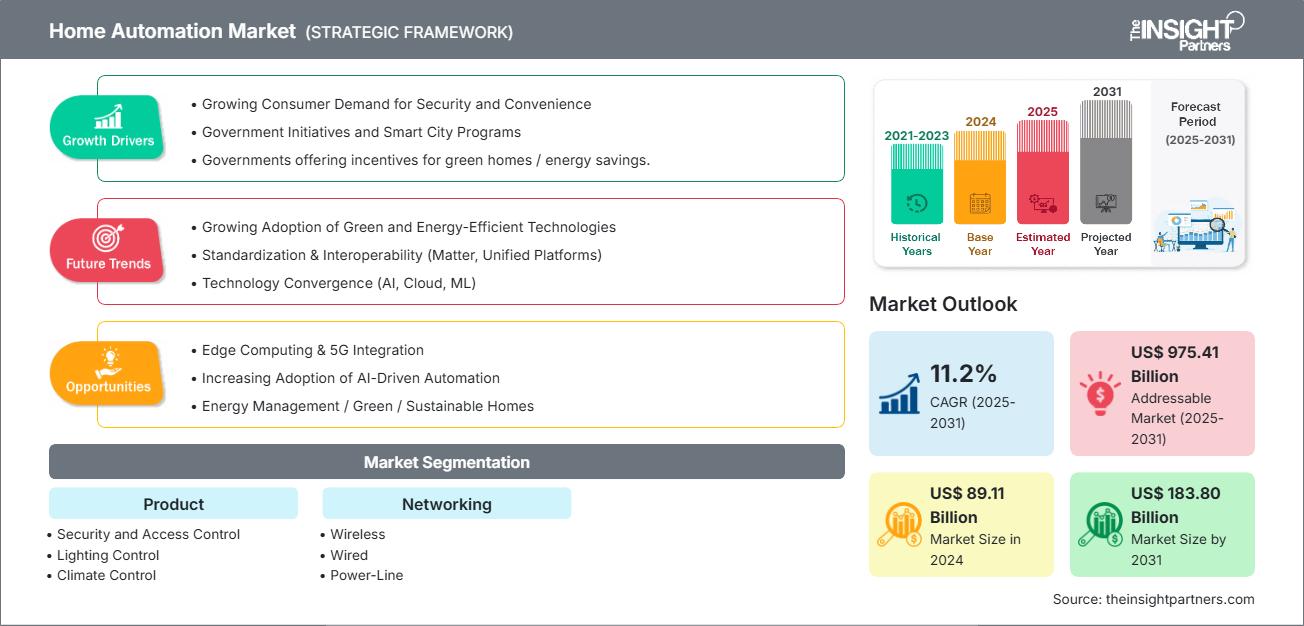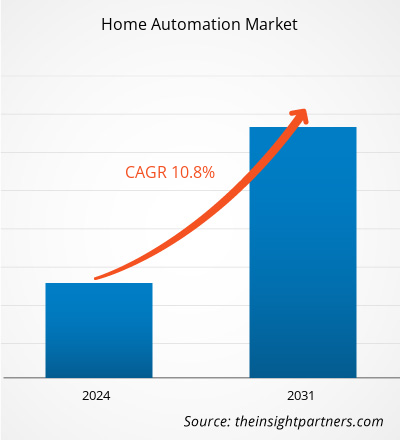Der Markt für Heimautomatisierung soll von 89,11 Milliarden US-Dollar im Jahr 2024 auf 183,80 Milliarden US-Dollar im Jahr 2031 anwachsen. Für den Markt wird zwischen 2025 und 2031 eine durchschnittliche jährliche Wachstumsrate (CAGR) von 11,2 % erwartet.
Marktanalyse für Heimautomatisierung
Der globale Markt für Heimautomatisierung verzeichnet ein starkes Wachstum, vor allem getrieben durch den Wunsch der Verbraucher nach Komfort, Energieeffizienz und Sicherheitsfunktionen in ihrem Zuhause. Verbesserte IoT-, KI- und drahtlose Kommunikationstechnologien haben vernetzte Smart-Home-Geräte in verschiedene Systeme integriert, darunter Beleuchtung, Klimatisierung, Unterhaltung und Haussicherheitssysteme. Da sich die Verbraucher zunehmend der Vorteile von Smart Homes bewusst werden, zeigt der beschleunigte Zugang über Smartphones, Sprachassistenten und leicht anpassbare Systeme das Wachstum der Smart-Home-Technologie. Während die Industrieländer weiterhin die führende Rolle bei der Einführung spielen, schließen die Schwellenländer dank zunehmender Internetnutzung und Urbanisierung schnell auf. Der Markt entwickelt sich aufgrund von Trends in den Bereichen Systemintegration, Nachhaltigkeit und personalisierte Automatisierungserlebnisse, die zukünftige Trends prägen werden, kontinuierlich weiter.
Marktübersicht für Heimautomatisierung
Der globale Markt für Hausautomation umfasst Technologien, die eine zentrale Steuerung von Haushaltssystemen wie Beleuchtung, Heizung, Lüftung, Klimaanlage, Haushaltsgeräten und Sicherheitssystemen ermöglichen. Dieser Markt wird durch die steigende Nachfrage nach mehr Komfort, Energieeffizienz und Sicherheit in den eigenen vier Wänden angetrieben. Die Integration mit Smartphones, Sprachassistenten und anderen intelligenten Geräten hat den Zugriff und die Nutzung dieser Systeme erleichtert. Der Markt umfasst sowohl die Modernisierung bestehender Häuser als auch die Automatisierung von Neubauten. Mit der zunehmenden Digitalisierung des Lebensstils der Verbraucher steigt die Nachfrage nach vernetzten und benutzerfreundlichen Wohnumgebungen stetig. Hausautomation ist ein wichtiger Trend im modernen Wohnen.
Sie erhalten kostenlos Anpassungen an jedem Bericht, einschließlich Teilen dieses Berichts oder einer Analyse auf Länderebene, eines Excel-Datenpakets sowie tolle Angebote und Rabatte für Start-ups und Universitäten.
Markt für Heimautomatisierung: Strategische Einblicke

- Holen Sie sich die wichtigsten Markttrends aus diesem Bericht.Dieses KOSTENLOSE Beispiel umfasst Datenanalysen, die von Markttrends bis hin zu Schätzungen und Prognosen reichen.
Treiber und Chancen des Heimautomatisierungsmarktes
Markttreiber:
Steigende Nachfrage nach Energieeffizienz:
Verbraucher legen zunehmend Wert auf die Reduzierung ihres Energieverbrauchs, um Kosten und Umweltbelastung zu senken. Hausautomationssysteme ermöglichen intelligentes Energiemanagement durch automatisierte Steuerung von Beleuchtung, Heizung und Kühlung und fördern so die Akzeptanz.Steigende Nutzung von IoT und Smart Devices:
Die zunehmende Verbreitung von IoT-fähigen Geräten ermöglicht die nahtlose Integration und Fernsteuerung von Heimsystemen. Diese Konnektivität verbessert das Benutzererlebnis und den Komfort und ermutigt immer mehr Hausbesitzer, auf Automatisierung umzusteigen.Zunehmende Sicherheitsbedenken:
Hausbesitzer legen Wert auf Sicherheit und Schutz. Dies führt zu einer steigenden Nachfrage nach intelligenten Überwachungskameras, Alarmsystemen und automatischen Schlössern. Diese Systeme bieten Echtzeitüberwachung und Warnmeldungen und sorgen so für mehr Sicherheit.Wachsende Halbleiterindustrie:
Automatisierung vereinfacht den Alltag durch die zentrale Steuerung von Geräten, Beleuchtung und Unterhaltungssystemen. Diese Benutzerfreundlichkeit spricht Verbraucher an, die mehr Komfort und Zeitersparnis suchen.
Marktchancen:
Integration erneuerbarer Energien:
Die Kombination von Hausautomation mit Solarmodulen und Energiespeicherung schafft Möglichkeiten für nachhaltige Wohnlösungen. Verbraucher können die Nutzung erneuerbarer Energien überwachen und optimieren, was die Attraktivität des Systems erhöht.Erschwingliche modulare Lösungen:
Die Entwicklung skalierbarer, kostengünstiger Smart-Home-Produkte macht die Automatisierung einem breiteren Publikum zugänglich. Modulare Systeme ermöglichen eine individuelle Anpassung an Bedarf und Budget und erweitern so die Marktreichweite.Kooperationen mit der Immobilienbranche:
Die Zusammenarbeit zwischen Technologieanbietern und Immobilienentwicklern ermöglicht Smart Homes in neuen Wohnprojekten. Diese Integration bereits in der Bauphase kann zu einer breiten Akzeptanz führen.
Segmentierungsanalyse des Marktberichts zur Heimautomatisierung
Der Markt für Heimautomatisierung ist in verschiedene Segmente unterteilt, um einen klareren Überblick über die Funktionsweise, das Wachstumspotenzial und die neuesten Trends zu geben. Nachfolgend finden Sie den Standardsegmentierungsansatz, der in den meisten Branchenberichten verwendet wird:
Nach Produkt:
Unterhaltungszentren:
Entertainment Center in der Heimautomatisierung integrieren Audio-, Video- und Mediensysteme für ein nahtloses und umfassendes Benutzererlebnis.Sicherheit und Zugangskontrolle:
Dieses Segment umfasst intelligente Schlösser, Alarmanlagen, Video-Türklingeln, Überwachungskameras und biometrische Zugangskontrollen, die verbesserte Sicherheit und Fernüberwachung bieten.Lichtsteuerung:
Lichtsteuerungssysteme automatisieren die Verwaltung der Innen- und Außenbeleuchtung mithilfe von Sensoren, Dimmern, Zeitplänen und Fernbedienung.Klimatisierung:
Die Hausautomation in der Klimaregelung umfasst intelligente Thermostate, HLK-Steuerungen und Lüftungssysteme, die Heizung, Kühlung und Luftqualität für Komfort und Energieeinsparungen optimierenOutdoor-Automatisierungssysteme
: Die Außenautomatisierung verwaltet Elemente der Außenumgebung wie Rasensprenger, Gartenbeleuchtung, Poolsysteme und Garagentore über eine zentrale SteuerungSonstige
: Dieses Segment umfasst verschiedene Automatisierungsgeräte wie intelligente Geräte (Kühlschränke, Öfen), Jalousien/Rollos, Energiemanagementsysteme, Sensoren und Sprachassistenten, die integrierte Smart Homes abrunden
Nach Netzwerk:
Verdrahtet:
Kabelgebundene Netzwerke verwenden physische Kabel – üblicherweise Ethernet, USB oder Powerline Communication (PLC) – um Geräte zu verbinden.Kabellos:
Drahtlose Verbindungen dominieren die Heimautomatisierung aufgrund der einfachen Installation, Flexibilität und zunehmenden Interoperabilität der Geräte.
Nach Geografie:
- Nordamerika
- Europa
- Asien-Pazifik
- Lateinamerika
- Naher Osten und Afrika
Der Markt für Heimautomatisierung in Nordamerika wird voraussichtlich das schnellste Wachstum verzeichnen. Diese führende Position ist auf ein hohes Verbraucherbewusstsein, die breite Nutzung fortschrittlicher Technologien und eine starke Infrastruktur sowie erhebliche Investitionen in Smart-Home-Innovationen und etablierte IoT-Ökosysteme in der Region zurückzuführen.IoT ecosystems in the region.
Regionale Einblicke in den Markt für Heimautomatisierung
Die Analysten von The Insight Partners haben die regionalen Trends und Faktoren, die den Markt für Heimautomatisierung im Prognosezeitraum beeinflussen, ausführlich erläutert. In diesem Abschnitt werden auch die Marktsegmente und die geografische Lage in Nordamerika, Europa, Asien-Pazifik, dem Nahen Osten und Afrika sowie Süd- und Mittelamerika erörtert.
Umfang des Marktberichts zur Heimautomatisierung
| Berichtsattribut | Details |
|---|---|
| Marktgröße im Jahr 2024 | 89,11 Milliarden US-Dollar |
| Marktgröße bis 2031 | 183,80 Milliarden US-Dollar |
| Globale CAGR (2025 – 2031) | 11,2 % |
| Historische Daten | 2021–2023 |
| Prognosezeitraum | 2025–2031 |
| Abgedeckte Segmente | Nach Produkt
|
| Abgedeckte Regionen und Länder | Nordamerika
|
| Marktführer und wichtige Unternehmensprofile |
|
Marktteilnehmerdichte für Heimautomatisierung: Auswirkungen auf die Geschäftsdynamik verstehen
Der Markt für Heimautomatisierung wächst rasant. Die steigende Nachfrage der Endnutzer ist auf Faktoren wie veränderte Verbraucherpräferenzen, technologische Fortschritte und ein stärkeres Bewusstsein für die Produktvorteile zurückzuführen. Mit der steigenden Nachfrage erweitern Unternehmen ihr Angebot, entwickeln Innovationen, um den Bedürfnissen der Verbraucher gerecht zu werden, und nutzen neue Trends, was das Marktwachstum weiter ankurbelt.

- Überblick über die wichtigsten Akteure auf dem Markt für Heimautomatisierung
Marktanteilsanalyse für Heimautomatisierung nach Geografie
Der asiatisch-pazifische Raum dürfte in den nächsten Jahren das schnellste Wachstum verzeichnen. Auch die Schwellenmärkte in Lateinamerika, dem Nahen Osten und Afrika bieten Anbietern von Heimautomatisierung zahlreiche ungenutzte Expansionsmöglichkeiten.
Der Markt für Heimautomatisierung wächst in jeder Region unterschiedlich. Nachfolgend finden Sie eine Übersicht über Marktanteile und Trends nach Regionen:
1. Nordamerika
Marktanteil:
Besitzt einen bedeutenden Anteil am WeltmarktHaupttreiber:
- Hohes Verbraucherbewusstsein und Bereitschaft, intelligente Technologien zu übernehmen.
- Fortschrittliche IoT-Infrastruktur und weit verbreitete Smartphone-Durchdringung.
- Starker Fokus auf Energieeffizienz und Sicherheitslösungen.
Trends:
Zunehmende Nutzung sprachgesteuerter Assistenten (Alexa, Google Assistant).
2. Europa
Marktanteil:
Wesentlicher Anteil der raschen UrbanisierungHaupttreiber:
- Strenge staatliche Vorschriften fördern Energieeffizienz und Nachhaltigkeit.
- Steigende Nachfrage nach intelligenten Sicherheits- und Überwachungssystemen.
- Steigendes verfügbares Einkommen und digitale Kompetenz.
Trends:
Zunehmende Nutzung der Heimautomatisierung mit integrierter erneuerbarer Energie.
3. Asien-Pazifik
Marktanteil:
Am schnellsten wachsende Region mit jährlich steigenden MarktanteilenHaupttreiber:
- Schnelle Urbanisierung und eine wachsende Mittelschichtbevölkerung.
- Zunehmende Verbreitung von Smartphones und Internet in Schwellenländern.
- Zunehmende Immobilienentwicklungen integrieren Smart-Home-Technologien.
Trends:
Verstärkter Fokus auf mobile, app-basierte Fernsteuerungssysteme.
4. Süd- und Mittelamerika
Marktanteil:
Wachsender Markt mit stetigem FortschrittHaupttreiber:
- Wachsendes Bewusstsein für die Vorteile der Energieeinsparung angesichts steigender Stromkosten.
- Steigende Investitionen in Smart Cities und vernetzte Infrastrukturprojekte.
- Erweiterung der Smartphone-Nutzerbasis
Trends:
Schrittweise Einführung intelligenter Sicherheitssysteme für die Sicherheit zu Hause.
5. Naher Osten und Afrika
Marktanteil:
Obwohl klein, wächst es schnellHaupttreiber:
- Wachsender Markt für Luxusimmobilien mit Smart-Home-Funktionen.
- Steigende Nachfrage nach verbesserter Sicherheit und Überwachung zu Hause.
Trends:
Verwendung von sprach- und mobilbasierten Heimautomatisierungssteuerungen.
Marktteilnehmerdichte für Heimautomatisierung: Auswirkungen auf die Geschäftsdynamik verstehen
Hohe Marktdichte und Wettbewerb
Der Wettbewerb ist aufgrund der Präsenz etablierter Unternehmen wie Johnson Controls, Siemens, Legrand und Schneider Electric stark. Regionale und Nischenanbieter wie Wink Labs, Fibaro, Abode Systems und Control4 tragen ebenfalls zum Wettbewerbsumfeld in verschiedenen Regionen bei.
Dieser hohe Wettbewerbsdruck zwingt Unternehmen dazu, sich durch folgende Angebote von der Masse abzuheben:
- Intelligente Lichtsteuerung
- Klima- und HLK-Automatisierung
- Sicherheit und Überwachung zu Hause
- Energiemanagementsysteme
Chancen und strategische Schritte
- Übernahme von Startups oder spezialisierten Unternehmen, um die technologischen Fähigkeiten, Produktportfolios oder Marktreichweite schnell zu erweitern.
- Zusammenarbeit mit Telekommunikationsanbietern, Immobilienentwicklern oder Technologieunternehmen, um Smart-Home-Lösungen in umfassendere Ökosysteme zu integrieren.
- Eintritt in Schwellenmärkte mit maßgeschneiderten, kostengünstigen Lösungen zur Erschließung neuer Kundensegmente.
Die wichtigsten Unternehmen auf dem Markt für Heimautomatisierung sind:
- Johnson Controls
- Siemens
- Legrand
- Schneider Electric
- Resideo Technologies, Inc.
- Snap One, LLC
- ABB
- Crestron Electronics, Inc.
- Leviton Manufacturing Co., Inc.
- Lutron Electronics Co., Inc
Haftungsausschluss: Die oben aufgeführten Unternehmen sind nicht in einer bestimmten Reihenfolge aufgeführt.
Weitere im Rahmen der Recherche analysierte Unternehmen:
- Chamberlain Group (MyQ)
- Leviton-Fertigung
- Arlo Technologies
- TP-Link (Kasa Smart)
- Belkin (WeMo)
- Eve Systems
- Savant-Systeme
- Crestron Elektronik
- Lutron Electronics
- ADT Inc.
- Vivint Smart Home
- Ring (im Besitz von Amazon)
- Abode-Systeme
- Wink Labs
- Fibaro
- Aqara
Neuigkeiten und aktuelle Entwicklungen zum Markt für Heimautomatisierung
Lutron Electronics Co., Inc. gibt die Übernahme von Orluna LED Technologies Limited bekannt, einem führenden britischen Hersteller, der auf hochwertige architektonische Beleuchtungskörper spezialisiert ist.
Im Juni 2025 gab Lutron Electronics Co., Inc., ein weltweit führendes Unternehmen für Lichtsteuerung, automatisierte Beschattungslösungen und intelligente Leuchten, die Übernahme von Orluna LED Technologies Limited bekannt, einem führenden britischen Hersteller, der auf hochwertige Architekturleuchten spezialisiert ist. Die Übernahme ist Lutrons erste außerhalb Nordamerikas.Johnson Controls, der weltweit führende Anbieter intelligenter, gesunder und nachhaltiger Gebäudelösungen, gab heute deutlich erweiterte KI-Funktionen in seiner digitalen Lösungssuite OpenBlue Enterprise Manager bekannt, die Teil des digitalen Ökosystems von OpenBlue ist.
Im November 2024 kündigte Johnson Controls, der weltweit führende Anbieter intelligenter, gesunder und nachhaltiger Gebäudelösungen, deutlich erweiterte KI-Funktionen in seiner digitalen Lösungssuite OpenBlue Enterprise Manager an, die Teil des digitalen Ökosystems von OpenBlue ist. Die Updates umfassen die ersten kundenorientierten generativen KI-Anwendungen, autonomere Gebäudesteuerungen und ein deutlich verbessertes Benutzererlebnis. Diese Updates ebnen den Weg für weitere KI-Verbesserungen im Jahr 2025, die sich auf weltweit anerkannte Leistungsstandards, optimierte Geräteleistung zur Kosteneinsparung und verbesserte Einhaltung gesetzlicher Vorschriften konzentrieren.
Marktbericht zur Heimautomatisierung – Abdeckung und Ergebnisse
Der Bericht „Marktgröße und Prognose für Heimautomatisierung (2021–2031)“ bietet eine detaillierte Analyse des Marktes, die die folgenden Bereiche abdeckt:
- Marktgröße und Prognose für die Heimautomatisierung auf globaler, regionaler und Länderebene für alle wichtigen Marktsegmente, die im Rahmen des Geltungsbereichs abgedeckt sind
- Markttrends und Marktdynamiken im Bereich Heimautomatisierung wie Treiber, Einschränkungen und wichtige Chancen
- Detaillierte PEST- und SWOT-Analyse
- Marktanalyse für Heimautomatisierung mit wichtigen Markttrends, globalen und regionalen Rahmenbedingungen, wichtigen Akteuren, Vorschriften und aktuellen Marktentwicklungen
- Branchenlandschafts- und Wettbewerbsanalyse mit Marktkonzentration, Heatmap-Analyse, prominenten Akteuren und jüngsten Entwicklungen für den Markt für Heimautomatisierung
- Detaillierte Firmenprofile
- Historische Analyse (2 Jahre), Basisjahr, Prognose (7 Jahre) mit CAGR
- PEST- und SWOT-Analyse
- Marktgröße Wert/Volumen – Global, Regional, Land
- Branchen- und Wettbewerbslandschaft
- Excel-Datensatz
Aktuelle Berichte
Erfahrungsberichte
Grund zum Kauf
- Fundierte Entscheidungsfindung
- Marktdynamik verstehen
- Wettbewerbsanalyse
- Kundeneinblicke
- Marktprognosen
- Risikominimierung
- Strategische Planung
- Investitionsbegründung
- Identifizierung neuer Märkte
- Verbesserung von Marketingstrategien
- Steigerung der Betriebseffizienz
- Anpassung an regulatorische Trends




















 Kostenlose Probe anfordern für - Markt für Heimautomatisierung
Kostenlose Probe anfordern für - Markt für Heimautomatisierung